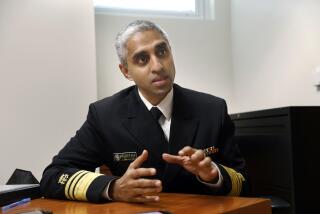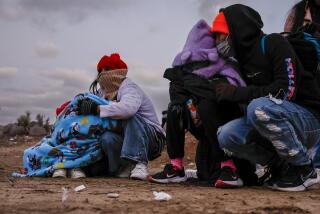Critical Conditions
LAANBAATAR, Mongolia — For the moment, Dr. Robert Greenburg is a spectator. He stands at the feet of a patient--a nude, unconscious woman shaved for surgery--and watches as a nurse daubs the abdomen with an iodine-based sterilizing solution. The liquid glistens yellowish-orange under the intense lights, the smell mixing with ammonia disinfectants to fill the operating room with a curdling stench.
It is the same smell, Greenburg says, that filled American operating rooms in the 1960s.
But this is the capital of Mongolia in the summer of 1997. The tools match the Mongolian doctors’ skills: Both are functional but out of date.
Greenburg’s job is to condense time, to bridge that gap between the way Mongolian doctors treat cervical cancer and the way it’s done in Southern California.
Lives hang in the balance.
“There’s absolutely no reason for women to die of this disease,” says Greenburg, 52, a retired Newport Beach obstetrician-gynecologist. “It’s a matter of allocating resources, which are very dear in this part of the world. But we feel we can make an immediate impact by giving women hope that if they have this disease, they have the opportunity for a cure.
“I’m not saying that I’m Albert Schweitzer, but this is wonderful work, and I’m lucky to be able to do this.”
It’s a common sentiment among Greenburg’s colleagues.
Two teams of American doctors--13 in all, mostly pediatricians and oncologists from Southern California--have come here to watch and help Mongolian physicians work in three of Ulaanbaatar’s 15 hospitals, and in three villages in the countryside.
During the week, the doctors will stumble across diseases they’ve rarely seen, such as rickets and diphtheria. They will work with equipment that could double as medical artifacts. And they will see difficult surgeries pulled off despite limitations in training, supplies and basic operating tools.
They will also witness the tragic consequences of misdiagnoses and limited access to equally limited health care.
By the time they leave, the doctors will have examined nearly 200 patients and consulted on dozens more cases. They will have directly saved the lives of several people, improved treatments for scores of others and passed along innovations that will help Mongolia’s doctors better deal with such ancient but curable killers of children as respiratory infection and diarrhea.
And the American doctors have only just begun.
*
Back home, the two teams of doctors could open their own medical plaza.
The first team is a group of nine pediatric specialists assembled by Dr. Richard MacKenzie, director of the Division of Adolescent Medicine at Childrens Hospital Los Angeles, which arrives a week early to explore the area around Ulaanbaatar (pronounced OO-lahn-bah-TAR).
In some ways, Mongolia is defined by where the people aren’t. Just over half the nation’s population of about 2.4 million live in cities, some 650,000 in Ulaanbaatar alone. The rest lead traditional semi-nomadic lives, moving their gers--canvas-and-felt houses resembling quilted igloos--with their herds of cattle, horses, sheep and goats over an area of about 600,000 square miles, slightly larger than California, Nevada, Utah, Arizona and New Mexico combined.
The natural beauty of Mongolia and the romance of nomadic life hide some very real agonies.
In the nephrology department, Dr. Francine Kaufman finds that the supply of insulin is sporadic at best, which makes it nearly impossible for the young diabetic patients to maintain proper levels of blood sugar.
“They keep running out,” she says. “It’s incredible. We throw it away like water.”
After returning to Los Angeles, Kaufman will begin a program that will ask the families of her department’s 600 young diabetic patients to donate insulin, needles and old equipment for measuring blood-sugar levels.
The supplies are critical if the young Mongolian patients are to survive.
“They’re just not growing,” Kaufman says. “They’re not entering puberty. They’re developing cataracts, swollen livers and stiff joints and the early onset of kidney disease. If we can’t reverse that, it’s like a death sentence in 10 years.”
Greenburg’s team of doctors is smaller than the pediatric crew, and is focused specifically on cervical cancer. The team is part of Medicine for Humanity, a Newport Beach-based organization that Greenburg formed two years ago with his mentor--Dr. Leo LaGasse of Cedars-Sinai Medical Center in Los Angeles--in hopes of eradicating cervical cancer in developing countries. The group--whose 100 volunteers include doctors, nurses and counselors--has already worked in the Philippines, South Africa and Mexico. The week after the Mongolia project, they would head to Malawi.
Cervical cancer is caused by the human papalomavirus, he says, which is sexually transmitted and can develop small cancerous growths on the cervix. Pap smears are an early but unreliable diagnostic test. Regular gynecological exams can remove the doubt and give doctors the chance to excise the cancerous tissue as though taking a biopsy.
But if the growth isn’t removed, the cancer will spread and the patient will die.
“This is a disease of poor people, of poor women who have had barriers placed on health care,” says Greenburg, of San Juan Capistrano. “Even in our country it is a disease of the underserved, the underprivileged. There are 6,000 [U.S.] deaths per year, primarily among the disenfranchised and the elderly.”
That translates into a mortality rate of about three per 100,000 women considered at risk, against an overall rate of those who develop the disease of 8.3 per 100,000. In Mongolia, the reported mortality rate is about 33 per 100,000, which Greenburg suspects is low because of misdiagnosis. And lack of treatment means that Mongolian women who contract cervical cancer usually die.
The problem, as in the U.S., ultimately comes down to access to medical care.
*
The American doctors have come to this rugged and harshly beautiful country because of a man in a dress.
He is Arnold Springer, 58, a longtime Venice Beach political activist, professor of Russian studies at Cal State Long Beach and director of the private Ulan Bator Foundation. Springer wears dresses because they make him feel whole, he says, cloaking his androgynous, Freudian sense of dual masculinity and femininity in long robes, bracelets and fingerless lace gloves set off by a graying beard that explodes from his chin.
*
Springer began the foundation--reflecting the former accepted Western spelling of Mongolia’s capital--seven years ago after accepting a controversial $200,000 settlement to drop his challenge to a housing development in Venice Beach. At the time, he pledged to use the money to bring Mongolia’s “concepts of space, light, air [and] horizons” to West Los Angeles, and conversely to bring a better understanding of the West to Mongolia.
“I thought they could inspire us because of the supreme and sublime nature of their country,” Springer says. “I wanted to encourage a people-to-people exchange, so we could learn from each other.”
In some quarters, he would be considered a mystical visionary, melding the physical and metaphysical. In other quarters, he’d be considered a nut.
But in Mongolia, he’s an angel, delivering doctors with lessons in new techniques to a place where they are sorely needed.
One of the places is the Maternal and Children’s Health Center, a vast and dank 800-bed complex that is clean but rugged. Windows are sealed with tape against winter winds, and some of the panes of glass are cracked. Spigots don’t work. Light bulbs are scarce, and in some places bare wires dangle where light fixtures should be.
The American pediatricians are curious but quiet as they negotiate the warren of dark hallways and austere rooms of battered metal beds. Paint and plaster peel and sag from the ceiling, telltale signs of old water leaks.
The physicians’ motives for making the trip are a mix of professional and personal. Dr. Ken Geller, head of Childrens Hospital Los Angeles’ Division of Otolaryngology, talks of the rewards of helping the sick in an environment not dominated by bureaucracy and insurance forms. Dr. Larry Ross, associate professor of clinical pediatrics at USC and Childrens Hospital, wonders at the implausibility of so many children dying, in essence, from chest colds that, untreated, develop into pneumonia.
But they also hold no illusions of bringing about immediate change.
“I’m interested in bringing my knowledge to a place where it could truly make a difference,” Kaufman says. “I’m not sure a few days will change a lot. This has to be the beginning. There has to be some sort of continuing relationship.”
The first links are made during the daily flow of watching the Mongolian doctors care for the ill.
One of the first patients Geller examines is Biambasuren, 16, who lives about 240 miles out in the countryside from Ulaanbaatar. In March, Biambasuren was chopping wood near his family’s ger when the ax bounced up and struck him in the center of the face. It was the blunt end of the ax, so there was no gash, but the blow shattered his central facial bones.
Despite what must have been agonizing pain, the family didn’t seek medical help until mid-June, when infected sores wouldn’t heal. As Geller squeezes pus from the open wound and feels for the knit of the shattered bones, Biambasuren sits immobile, trickles of tears the only sign of pain.
“The bones have set abnormally, and there’s chronic bone infection,” Geller explains as he works. “The sinuses are all filled and the skin is open. He needs reconstructive surgery.”
Then, turning to the Mongolian doctors, he asks in Russian, “Did you take blood for a bacterial check? No? You should do that first.”
Later, away from the doctors, the frustration seeps out.
“It’s all very romantic when you’re out there in the countryside with the gers and the horses, but then you see what goes on,” Geller says in a level but intense voice. “People joke about, ‘What did you doctors ever do before antibiotics?’ Well, this is what we did. Kids went deaf.
“People died from ear infections, from injuries like this.”
Accidents are the leading cause of death among children. They range from car crashes to farm-related injuries that can occur hours from Mongolia’s main medical center.
Little trauma care is available outside the capital. In many cases, families seek medical help only after injuries haven’t healed after several months.
Other leading causes of death are respiratory infections, diarrhea and parasitic infections. Those illnesses have common roots in chronic poor nutrition, limited access in the countryside to medical help and supplies--including key medicines--and unhealthy living conditions exacerbated by winter temperatures that drop to 40 below zero.
Yet, the doctors suspect those numbers might be misleading. They suspect untold numbers of children die in the countryside of illnesses misdiagnosed as flu or diarrhea.
Diseases rare in the U.S. crop up with regularity, such as iron and iodine deficiencies, and brucellosis--a bacterial infection from drinking unpasteurized milk that causes recurring fevers, sweats and joint pain. For reasons that are unclear, chronic hepatitis is rampant, as are kidney and bladder stones among children.
In the U.S., kidney stones are removed or pulverized with sonic equipment; in Mongolia, if they don’t dissolve with dietary treatment, the kidney often is removed.
Finding solutions to some of these problems has become the American doctors’ mission. During the visit, the two teams would watch and advise and begin sketching out a report from which Springer and the doctors hope to draw a blueprint for a four-year plan to rejuvenate Mongolia’s health care system.
Springer hopes to make the medical exchange program--endorsed by the Mongolian Health Ministry and directors of the oncology and pediatric hospitals--long-term and self-sustaining, financed by Western companies investing in Mongolia’s nascent oil industry.
International medicine can be expensive. Springer’s foundation long ago went through the $200,000 settlement and now gets by on sporadic donations and about $20,000 in each of the last two years from Springer’s teaching salary.
The $42,000 budget for the Mongolia trip was partially underwritten by a $16,000 grant from the U.S. Mongolia Business Council. An additional $15,000 grant Springer expected from the Soros Foundation failed to materialize, forcing him to scramble to cover the bills in Mongolia. As the trip ended, the foundation was between $6,000 and $9,000 in debt, which Springer describes as “manageable.”
Now he’s focusing on financing future trips under the four-year plan that’s still being devised.
“I want to have a significant exchange of medical people between both countries,” Springer says. “I want the Mongolian doctors and support staff put through our rotations to see what it’s like in Southern California medical institutions.
“Then, I want them to come back here and apply what they’ve learned and work with us to transform the hospitals.”
More to Read
Sign up for Essential California
The most important California stories and recommendations in your inbox every morning.
You may occasionally receive promotional content from the Los Angeles Times.










